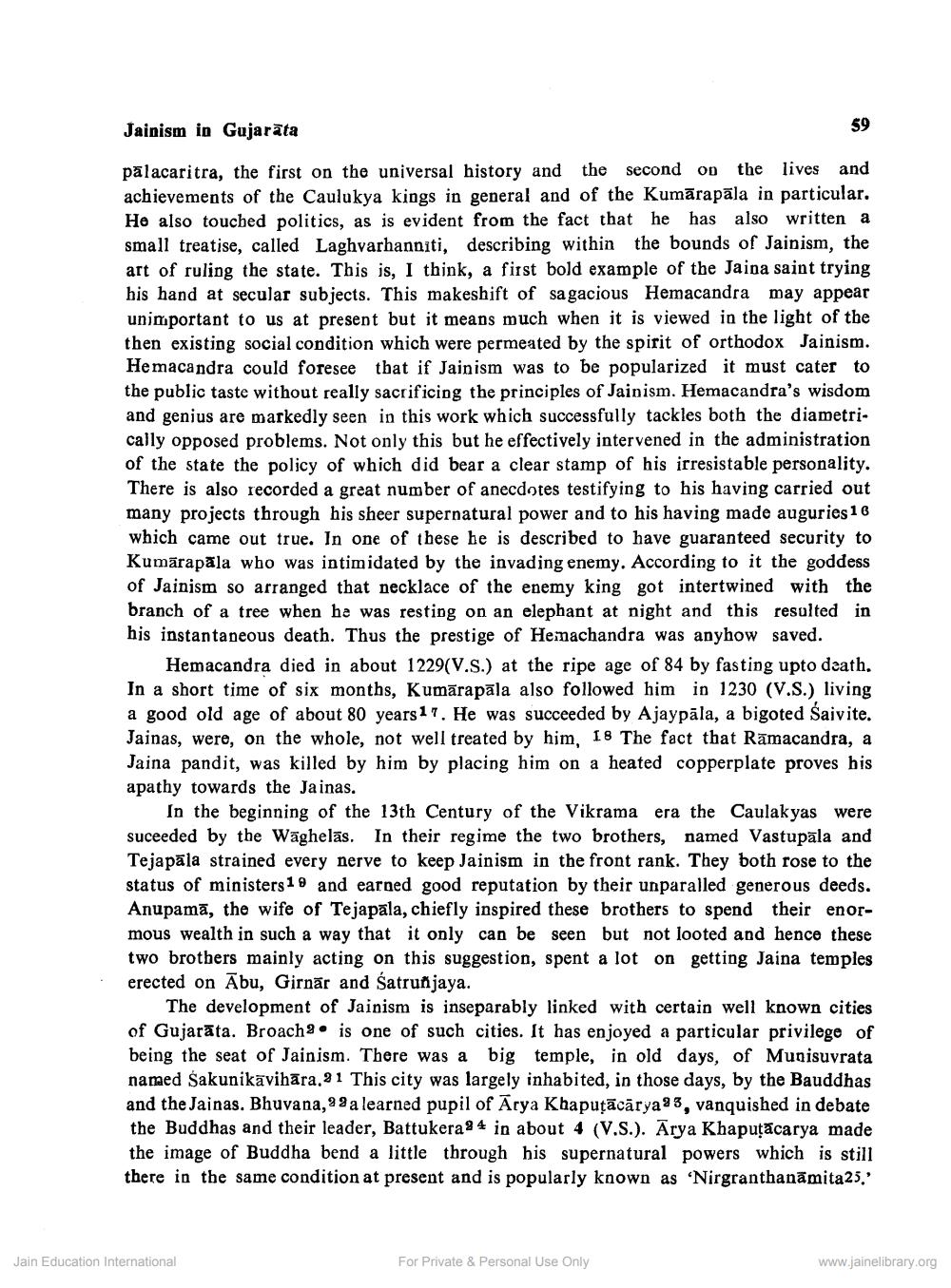________________
Jainism in Gujarāta
59 pālacaritra, the first on the universal history and the second on the lives and achievements of the Caulukya kings in general and of the Kumārapāla in particular. He also touched politics, as is evident from the fact that he has also written a small treatise, called Laghvarhanniti, describing within the bounds of Jainism, the art of ruling the state. This is, I think, a first bold example of the Jaina saint trying his hand at secular subjects. This makeshift of sagacious Hemacandra may appear unimportant to us at present but it means much when it is viewed in the light of the then existing social condition which were permeated by the spirit of orthodox Jainism. Hemacandra could foresee that if Jainism was to be popularized it must cater to the public taste without really sacrificing the principles of Jainism. Hemacandra's wisdom and genius are markedly seen in this work which successfully tackles both the diametrically opposed problems. Not only this but he effectively intervened in the administration of the state the policy of which did bear a clear stamp of his irresistable personality. There is also recorded a great number of anecdotes testifying to his having carried out many projects through his sheer supernatural power and to his having made auguries 16 which came out true. In one of these he is described to have guaranteed security to Kumārapāla who was intimidated by the invading enemy. According to it the goddess of Jainism so arranged that necklace of the enemy king got intertwined with the branch of a tree when he was resting on an elephant at night and this resulted in his instantaneous death. Thus the prestige of Hemachandra was anyhow saved.
Hemacandra died in about 1229(V.S.) at the ripe age of 84 by fasting upto death. In a short time of six months, Kumārapāla also followed him in 1230 (V.S.) living a good old age of about 80 years 17. He was succeeded by Ajaypāla, a bigoted Saivite. Jainas, were, on the whole, not well treated by him, 18 The fact that Rāmacandra, a Jaina pandit, was killed by him by placing him on a heated copperplate proves his apathy towards the Jainas.
In the beginning of the 13th Century of the Vikrama era the Caulak yas were suceeded by the Wāghelas. In their regime the two brothers, named Vastupala and Tejapāla strained every nerve to keep Jainism in the front rank. They both rose to the status of ministers 19 and earned good reputation by their unparalled generous deeds. Anupamā, the wife of Tejapala, chiefly inspired these brothers to spend their enormous wealth in such a way that it only can be seen but not looted and hence these two brothers mainly acting on this suggestion, spent a lot on getting Jaina temples erected on Ābu, Girnār and satrunjaya.
The development of Jainism is inseparably linked with certain well known cities of Gujarāta. Broacha • is one of such cities. It has enjoyed a particular privilege of being the seat of Jainism. There was a big temple, in old days, of Munisuvrata named Sakunikāvihāra.81 This city was largely inhabited, in those days, by the Bauddhas and the Jainas. Bhuvana, a 3 a learned pupil of Arya Khapuțācāryaa3, vanquished in debate the Buddhas and their leader, Battukera 8 4 in about 4 (V.S.). Ārya Khapuţăcarya made the image of Buddha bend a little through his supernatural powers which is still there in the same condition at present and is popularly known as 'Nirgranthanāmita 25,
Jain Education International
For Private & Personal Use Only
www.jainelibrary.org




